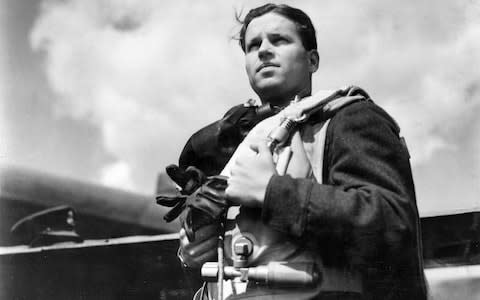Dambusters 75th anniversary: How the Second World War raid unfolded, hour by hour
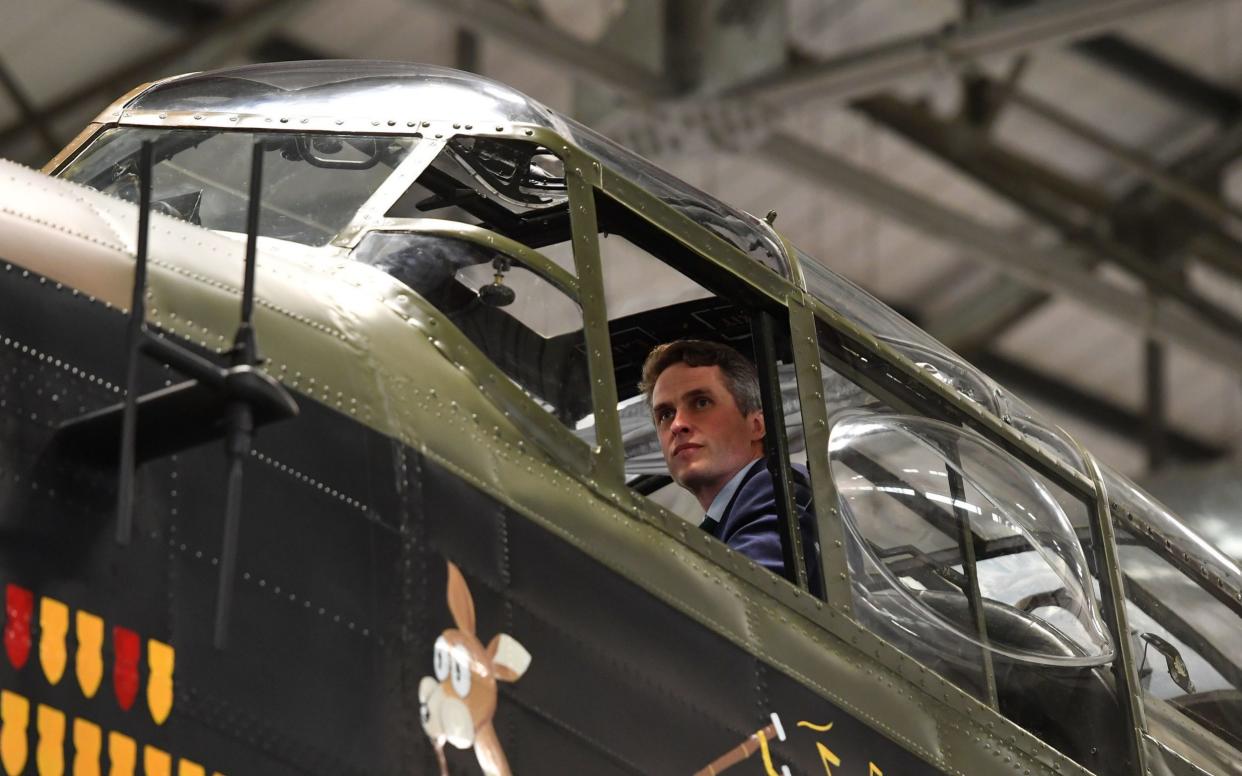
Today is the 75th anniversary of the Dambusters raid
1943 mission targeted key dams in Hitler's industrial heartland
A total of 133 aircrew left on board 19 Lancaster bombers
Relive one of WWII's most storied moments hour by hour below
Gavin Williamson, the Defence Secretary, said on Wednesday it was "very fitting" that Britain's cutting-edge F-35 Lightning stealth fighter jets would carry the name of the squadron that carried out the daring Dambusters raid.
Mr Williamson announced the imminent arrival of the supersonic warplanes on a visit to RAF Coningsby on the 75th anniversary of the Dambusters mission.
The Lancasters flown by 617 squadron in the Second World War used Barnes Wallis's revolutionary bouncing bombs to target and disable Hitler's industrial heartland during their night-time mission on May 16/17 1943.
The squadron was recently stood back up for the F-35 jets, which will be based at RAF Marham in Norfolk and are expected to arrive next month.
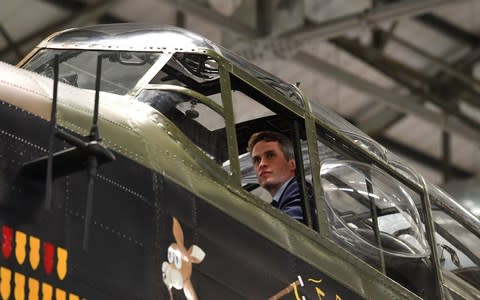
Mr Williamson announced the arrival of the F-35s while stood in front of a Lancaster Bomber in a hangar at the Battle of Britain Memorial Flight on Wednesday.
"If you think about what the Dambusters were doing 75 years ago they were using the very cutting-edge technology in order to be able do the job that they had been asked to do," he said.
"If you think about the modern 617 squadron, we're going to be giving them the very best of technology, the very cutting edge of technology, the very best and the most advanced aircraft in the whole world and it's fitting that those that have such an amazing jet have and carry that squadron name."
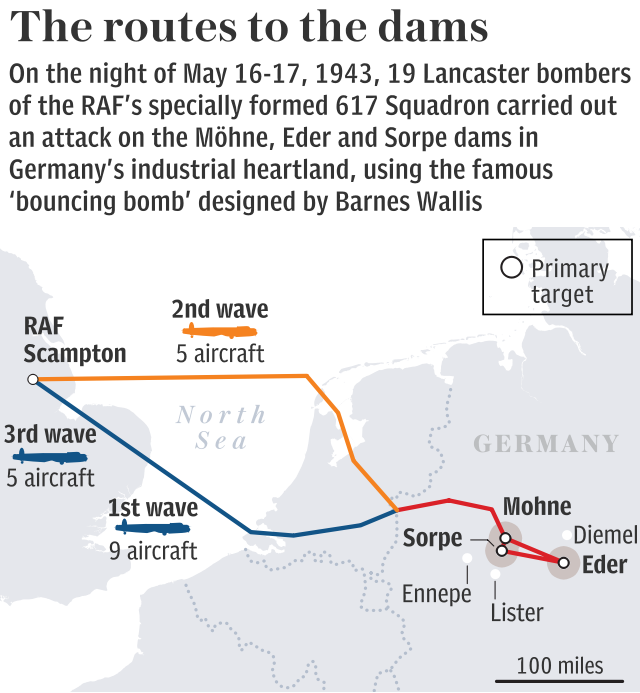
He was shown inside the cockpit of a Lancaster, viewed a Spitfire and paid tribute to the "sacrifice" of the original 617 squadron.
A planned Lancaster Bomber flight to mark the Dambusters' 75th anniversary had been cancelled due to windy conditions.
The flyover was instead conducted by a 29 Sqn Typhoon aircraft after weather conditions, particularly the wind, were considered too dangerous for the BBMF Lancaster, a Battle of Britain Memorial statement said.

A note was also struck at the Bomber Command Memorial in London's Green Park where 53 pairs of flying gloves were laid out to represent the men who died.
Relatives of those who took part in the 1943 raid and an RAF bugler signalled a minute's silence.
A total of 133 aircrew left for the raid on board 19 Lancaster bombers from RAF Scampton, led by Wing Commander Guy Gibson, but during the mission 53 men were killed and three were captured.
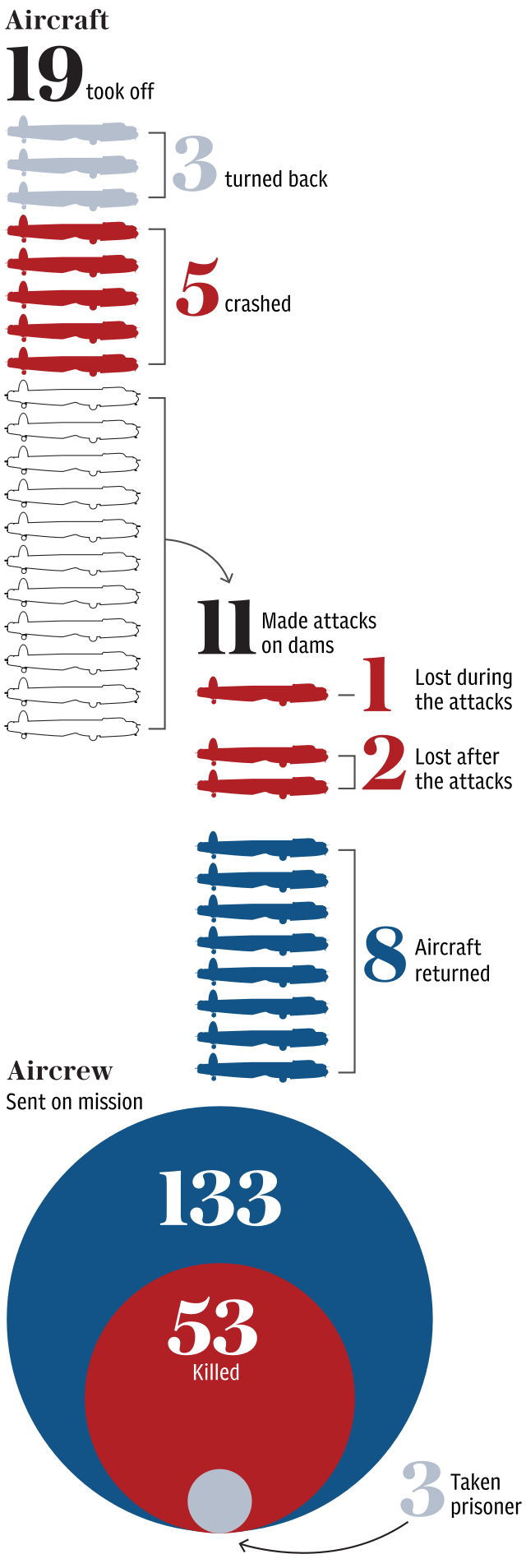
Squadron Leader George "Johnny" Johnson, Britain's last surviving Dambuster, was part of 617 Squadron, which carried out a night of raids on German dams in an effort to disable Hitler's industrial heartland.
The 96-year-old, of Bristol, said the anniversary on Wednesday night and Thursday morning emphasised the importance of the raid an
Read our updates of the attack in real time below
It is 1943, and Britain is bombing Germany. Night after night our airmen brave a storm of searchlights, machine guns, flak shells and fighters. Air Chief Marshall Arthur “Bomber” Harris believes the Nazis can be broken by sheer weight of explosives.
But what if he is wrong? Barnes Wallis is a weapons designer at Vickers who believes that carefully targeted raids could knock out German war production. He has designed a strange new bomb which he says can bounce over the torpedo nets protecting the dams which supply hydroelectric power to the German industrial heartland of the Ruhr.
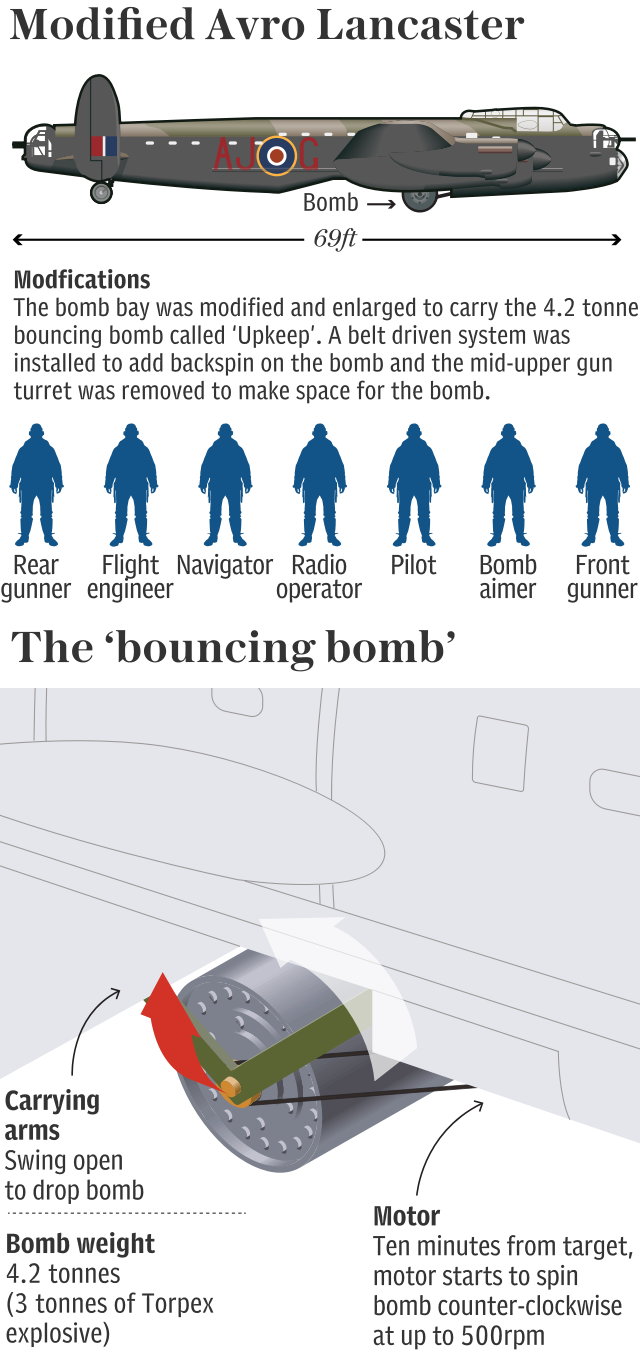
In a series of political maneuverings, Wallis's plan is approved over Harris' opposition. The problem: it will only work when the reservoirs are at their fullest from seasonal rainfall in May. That gives the RAF just eight weeks to prepare for a difficult night raid deep behind enemy lines using barely-tested technology.
Under strict secrecy, a new unit – 617 Squadron – is formed of pilots from across the British Empire. They train intensely and their aircraft are heavily modified. Finally, on May 16, with a full moon rising, the mission begins. Operation CHASTISE is go.
The final survivors return
The plane to return was O-Orange. The crew had a smooth flight back until they reached the Dutch coast, where the rising sun had made them an easy target. The Germans fired but they emerged unscathed.
It wasn't all easy though. Townsend found there was an oil problem with one of the engines so he had to shut it down immediately. The final stretch was subsequently much slower than it should have been.
Nevertheless, at 6.15am, the battered O-Orange came in to land at Scampton, where the crew were greeted by Air Chief Marshall Harris. The Dambusters raid was over.
06:15Townsend’s Lancaster AJ-O landing at RAF Scampton. AJ-O is the last aircraft from to return safely. Operation Chastise is over. #Dambusters75pic.twitter.com/k2CQ0d4gpk
— Ministry of Defence ���� (@DefenceHQ) May 17, 2018
One bomb came back unused
Anderson returned to base at RAF Scampton with his bomb. It was the only one.
04:23Anderson in AJ-Y: “(in code) RETURNING TO BASE UNSUCCESSFUL” #Dambusters75 - Anderson arrived back with an intact “Upkeep” mine. pic.twitter.com/yY1REb85gI
— Ministry of Defence ���� (@DefenceHQ) May 17, 2018
Others continued to arrive home, meanwhile, including Gibson and Shannon.
03:28 and 04:06Gibson and Shannon’s Lancasters land at RAF Scampton. #Dambusters75pic.twitter.com/LmpeQyhgBu
— Ministry of Defence ���� (@DefenceHQ) May 17, 2018
One last attempt
There was one final target for the night: Ennepe Dam. After much effort, Bill Townsend flew the O-Orange through thick mist and flak to eventually find what he thought was the dam.
Like the Eder dam, it was treacherous terrain for a perfect attack run. After three attempts, they dropped their bomb on the fourth run at 3.37am. It bounced twice, then sank, 50 yards short of the dam wall.
There was a huge explosion in the water, but it had made little impact on the dam wall itself.
It was the last bomb to fall. There remains debate about whether it was in fact the Ennepe Dam they had targeted, or Bever Dam.
The heroes return
The first aircraft to have completed the mission, piloted by Maltby, landed back on British soil at 3.14am.
03:11Maltby’s Lancaster AJ-J landing at RAF Scampton. First aircraft to complete mission. #Dambusters75pic.twitter.com/xi3YfDUfL0
— Ministry of Defence ���� (@DefenceHQ) May 17, 2018
There was no signal given to the men to pull off the mission. Instead, each aircraft had to make its own decision. Gibson told his men: “This squadron will either make history or be completely wiped out.”
03:19 – 03: 23 Martin and McCarthy’s Lancasters land at RAF Scampton #Dambusters75
— Ministry of Defence ���� (@DefenceHQ) May 17, 2018
Last attack on Sorpe
While Gibson et al had been destroying the Mohne earlier, Joe McCarthy had been trying to hit the Sorpe.
Unknown to McCarthy, the attack had been weakened by the loss of four planes from the mission, with two crews dead and two back on British soil.
At almost 1am, they had finally scored a hit after 10 runs. As predicted, one was not enough but they hoped they had at least damaged it.
03:00McCarthy in AJ-T: “GONER 79C” #Dambusters75 - Sorpe Dam is breached. pic.twitter.com/6zi2pZ2CMD
— Ministry of Defence ���� (@DefenceHQ) May 17, 2018
About two hours later, Ken Brown and his crew arrived at the Sorpe. Several dummy runs confirmed the damage inflicted by McCarthy had been considerable, but it had not collapsed.
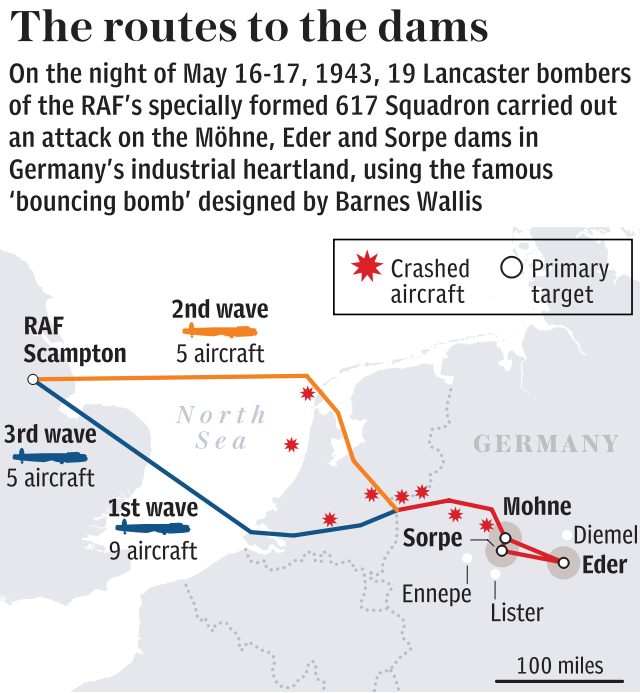
Finally, at 3.14am after at least six dummy runs, Brown was happy with his approach and the bomb was dropped.
The aim was true and the blast struck the dam. More damage was inflicted, but the dam just about remained standing.
At 3.23 am, they informed HQ that they had hit the dam but it had not been breached. They had done their best, but it was time to head home.
03:23Brown on AJ-F: “GONER 78C” #Dambusters75pic.twitter.com/4aXWl6xg23
— Ministry of Defence ���� (@DefenceHQ) May 17, 2018
The last plane to be downed
On the way back, Young's Lancaster was the last to be lost on the mission. At 2.58am, the men were shot down by enemy fire around Castricum aan Zee on the coast of Holland and crashed into the sea. There were no survivors. They had been so close to safety.
02:35 – 02:58Ottley, Maudslay and Young’s Lancasters all brought down by enemy flak. One survivor: F. Tees. #Dambusters75pic.twitter.com/nswic4oItn
— Ministry of Defence ���� (@DefenceHQ) May 17, 2018
The shooting down of A-Apple meant eight of the 19 planes had been lost on the mission.

Casualties rise
At 2.30am, Warner Ottley, flying in C-Charlie, were ordered to attack the Lister Dam, an instruction that the crew confirmed had been received.
Two minutes later, however, they were told the attack the Sorpe instead. This time there was no acknowledgement.
In an area north of Hamm, they were caught by flak and crashed. Miraculously, Sergeant Fred Tees survived - the only one on board who was able to escape the burning wreckage. He was picked up by a farmer and became the third prisoner of war.
Meanwhile, at around the same time, Maudsley’s crew in Z-Zebra was approaching the heavily defended town of Emmerich. It is believed the plane had already been damaged by the first blast at the Eder dam. In any case, they were no match for the flak at the oil storage facilities near the town. It was shot down and all seven perished.
Anderson heads to the Sorpe
02:28Group HQ to Anderson in AJ-Y: “to ‘Y’ DINGHY” Anderson replies: “RECEIVED” #Dambusters75pic.twitter.com/UZBR1Phivb
— Ministry of Defence ���� (@DefenceHQ) May 17, 2018
Cyril Anderson, in Y-York, is ordered to attack the Sorpe at 2.28am.
Who is left?
02:10From Group HQ to Gibson in AJ-G: “HOW MANY AIRCRAFT OF FIRST WAVE ARE AVAILABLE FOR ‘C’ [Sorpe Dam]?” Gibson replies: “NONE” #Dambusters75pic.twitter.com/lZQ6NViCfE
— Ministry of Defence ���� (@DefenceHQ) May 17, 2018
Time for the reserve wave
With two dams down, the reserve wave was still heading to their targets.
However, Lewis Burpee strayed off course in S-Sugar, and flew over a German airfield at Gilze-Rijen near Tilburg. The plane was hit by flak, caught fire and exploded, before crashing on the edge of the airfield, killing all on board.
02:00Burpee’s Lancaster AJ-S brought down by enemy flak. No survivors. #Dambusters75pic.twitter.com/xyQxw2bQYW
— Ministry of Defence ���� (@DefenceHQ) May 17, 2018
Burpee's wife was expecting their first child.
'It's a sight I shall never forget'
With one down, it was time to head to the next target 45 miles away: the Eder Dam.
The terrain meant any attack run would be incredibly difficult. And given they hadn't even had a scale model to look at, they didn't know exactly what to expect.
The Lancasters, with a wing span of 102ft, dropped down from over 1000ft to the lake and flew a curving approach, hopping over a spit of land which rose to 50ft less than a mile from the target.
Shannon tried four times to get the correct flight path but in vain. At 1.30am, Maudsley had a couple of attempts, but again, it was too difficult.
On Shannon's sixth attempt, they were in the right position to drop the bomb. Down it fell, bouncing twice before striking the wall. There was a huge blast - but the dam remained seemingly intact.
Now it was Maudsley's turn. His run was good and he dropped the payload. Moments later, as he soared up into the sky, the detonation lit up the valley.
Again, the dam was still standing. Next up was Les Knight, flying N-Nuts - their last chance.
At 1.47am, he began his first run but didn't get it quite right. Five minutes, he began his second run. He dropped the bomb 450 yards from the dam and it bounced three times before smacking the wall and sinking. There was a huge blast and a column of water soared into the air. The dam began to collapse, sending 202 million tons of water cascading down the valley and beyond.
"We could see the water gushing out and all the masonry coming down," said Sid Hobday, according to James Holland in Dam Busters: The Race to Smash the Dams. "It's a sight I shall never forget."
01:54Gibson in AJ-G: “DINGHY” #Dambusters75pic.twitter.com/jTCP9FezvN
— Ministry of Defence ���� (@DefenceHQ) May 17, 2018
At 1.54am, Gibson sent his signal, Dinghy, to say the second dam, Eder, had been breached.
'It's gone!'
Next up was Martin.
He dropped his bomb as Gibson distracted the gunners by flowing close by. Again, the aim was a bit off - the bomb veered to the left and exploded near the bank of the reservoir 20 yards from the dam.
Young was called up and made the perfect approach. He dropped his bomb and it hit the centre of the dam. Again, it appeared to stay intact.
But as Maltby approached at 00.49, he could see the centre of the dam was beginning to crumble. Sgt Vivian Nicholson wrote in his log: “Bomb dropped. Wizard.’
As the bomb exploded, the dam collapsed. "There was an excited yell. It's gone! It's gone", recalled Shannon, who had been preparing for his run.
At 00.56, Gibson sent a signal to base using morse, using the name of his beloved pet Labrador as a codeword to say the dam had been breached.
00:56 Radio Transmission: GONER 710A from Gibson in AJ-G - the Möhne dam is breached. #Dambusters75pic.twitter.com/lKQmgrnD3A
— Ministry of Defence ���� (@DefenceHQ) May 16, 2018
The attack begins
Not long after Astell bought it near Borken, Mick Martin, in P-Popsie, arrived at the Mohne along with Gibson and Hopgood.
Gibson admitted the ferocity of the flak fired at them as they neared the dam surprised him. He began the first run at 00.28, turning on his spotlights so his navigator could tell him when he was flying at exactly 60ft and, flying at 230mph. Gibson had never been so scared in his life.
He dropped the bomb and there were was a huge blast in the water. But the dam remained in tact.
Not it was Hopgood's attempt. The first attack had made the soldiers all too aware of what was going on and trained their fire on M-Mother as soon as the spotlights came on.
The plane was hit and the bomb dropped too late. It bounced over the dam, destroying the power house as it exploded at the foot of the dam wall.
00:34Hopgood’s Lancaster AJ-M shot down over the Mohne dam. Two crew members, Fraser and Burcher survive. #Dambusters75pic.twitter.com/HY3DzEy4fN
— Ministry of Defence ���� (@DefenceHQ) May 16, 2018
The men bailed out, but only the rear gunner and bomber aimer were successful, the other crew members perished.
May 17 - 00.15
The power cables are proving as fatal as feared.
Shortly after midnight, Astell in B-Baker had started to lag behind. A few miles south of Borken, Maudslay's aircraft flew over some power lines. Following close behind, Knight, in N-Nuts, cleared them too but moments later, Astell's plane collided with the high tension cables north of the Ruhr. There was a ball of flames and no survivors. The bomb on board reportedly smashed windows in homes nearby and left a huge crater.
00:15Astell’s Lancaster AJ-B has hit powerlines. No survivors. #Dambusters75pic.twitter.com/x3FufkeOUo
— Ministry of Defence ���� (@DefenceHQ) May 16, 2018
Five planes had already been lost and they hadn't even reached the dams.
Another plane downed
Barlow's plane hit the power lines in enemy territory after being hit with flak. There were no survivors.
23:50Barlow’s Lancaster AJ-E, has hit power lines due to low flying. No survivors. #Dambusters75pic.twitter.com/VS06l3ELpe
— Ministry of Defence ���� (@DefenceHQ) May 16, 2018
The crews flew beneath power cables, along roads and below the level of the surrounding trees to avoid enemy defences, but as they were blown off course they hit obstacles.
Gibson’s wave made their way across the North Sea and into the Netherlands.
His formation - or 'vic' - crossed the coast at the ominously named island of Overflakee, but flying fast and low they took the Germans by surprise, crossing the heavily defended island unscathed.
The second formation, ten minutes behind, climbed higher to use their radio aids and discovered the unforecast wind, but the German radars picked them up and they opened fire.
The first planes lost
The second wave flies over the Dutch coast, and immediately the enemy makes itself known.
K-King strays over the wrong part of the coast and is hit by flak: the first casualty of Operation CHASTISE.
W-Willie is caught by a stream of tracer fire from a coastal island reconnaissance had declared clear. A lucky hit severs the intercom, and with no way of talking to each other the crew is forced to turn back.
Nearby, H-Harry flies too low and scrapes the water with a terrifying shock. The Upkeep is torn out of its calipers and whipped back along the underside of the bomber. It drives the rear landing gear up into the tail, smashing the toilet and drenching the rear gunner in seawater and disinfectant. “Christ, it’s wet back here!” he shouts.
H-Harry gets clear – but without its payload, it too must go home, water draining from its open bomb bay. The second wave has lost three out of five planes in just three minutes.
"No talking" - Bombers off course
In G-George, Guy Gibson’s navigator tells him: “Five minutes to go to the Dutch coast, Skip.” Someone begins whistling. Someone else says: “Shut up!”
The first wave, however, is off course. Instead of undefended land they are approaching Over Flakee, a well-defended island. “Stand by, front gunner,” says Gibson. “We’re going over. No talking. Here we go.”
Intrepid crossing of the North Sea
The first and second waves are now crossing the featureless North Sea. Ahead of them lies the Dutch coast, bristling with defences. If they cross in the wrong place, they could be torn apart.
With no landmarks, staying on target amidst even light winds can be very difficult. The Lancasters are forced to periodically pop their heads above 100 feet to get a fix on the Gee.
The first two waves
The last of the first two waves roar down the runway and into the air, followed minutes later by Joe McCarthy in T-Tommy.
Harry Humphries watches them go. He still does not know what the mission is; he won’t until Gibson returns. Nevertheless, Operation CHASTISE has begun.
Chocks away
The second green light goes and Guy Gibson’s plane now lifts off. Joe McCarthy stands by the hanger watching them, clenching and unclenching his fists in frustration.
Finally someone appears with a compass card. McCarthy races back to the new aircraft, T-Tommy – but as he gets out of his van he accidentally pulls the ripcord instead of the door handle and his white silk parachute blooms from the backpack.
Green light for go
At 21:28 a green lamp signals the first planes to leave. With Q-Queenie out of order, E-Easy goes first. The Lancaster picks up speed and lifts its massive bulk into the summer evening.
Ruth Ive, who was eating dinner, recalls:
“Somebody brought us out some dinner, and then the whole place absolutely rattled and shook. The ground seemed to heave as the planes took off ,and they just seemed to miss our hut.”
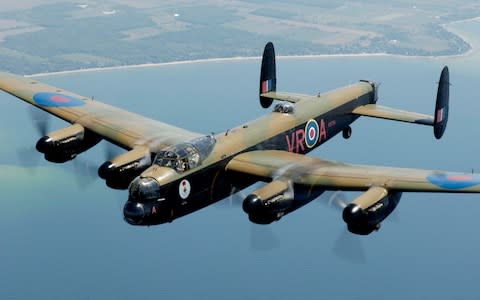
Mechanical difficulties
Joe McCarthy and his men get abroad the spare aircraft that flew up from Wiltshire earlier today. But it hasn’t been properly tested and there is no compass deviation card on board.
Cursing, McCarthy grabs a van and drives back to the hanger. “Where are those lazy, idle incompetent compass adjusters?” he shouts at the ground crew. Harry Humphries calms him down while the others scramble to help, but Q-Queenie will miss the first wave.
Start your engines
The sun has not yet set, but it’s time to go. At 9pm exactly a red flare whooshes into the sky, signalling the first and second waves to start their engines. The propellers turn slowly at first; then with sparks and smokes, the engines growl to life.
The aircraft have codenames based on letters of the alphabet: Gibson, for instance, rides G-George. One plane, Q-Queenie, now finds its engines are not working properly.
American Joe McCarthy shouts at his men: “For Christ’s sake, get into that spare aircraft before some other bugger gets there and we don’t get to go!”
Radar switches on
The Eastern Chain radar stations are switched on. The Lancasters of 617 squadron carry a device called Gee, which uses radar pulses to get a fix on their location. It doesn't work perfectly, but it will help the crew navigate the dark and unfamiliar country beneath them.
A premonition of death
The men of 617 Squadron climb into their planes. Some clutch mascots or keepsakes, while others perform rituals such as “watering” the rear landing gear. An RAF photographer is on hand to capture the moment.
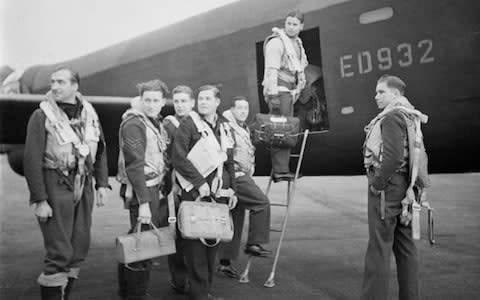
Then David Shannon is taken aside by his pilot, flight lieutenant John "Hoppy" Hopgood:
“As we were walking out to our aircraft Hoppy grabbed me and we went round the back of a hangar to smoke a cigarette. He said ‘I think this is going to be a tough one, and I don’t think I’m coming back, Dave.’
“That shook me a bit. ‘Come off it, Hoppy,’I said, ‘you’ll beat these bastards; you’ve beaten them for so long, you’re not going to get whipped tonight.”
The inside of the Lancasters is cramped and dark, and it stinks of oil, metal and rubber.
The inside of the modified Lancasters is cramped and dark, like a coffin, and it stinks of oil, metal and rubber.
All aboard
Buses begin to take the men of the first and second waves to their planes. One of them, David Shannon, is late, so everyone starts shouting at him. Eventually he walks out, grinning as the others call; “Don’t let us worry you!” “Have you cleaned your teeth?”
A beautiful summer's eve
The men lounge on the grass in the warm evening. Les Munro, a New Zealander of Scots parentage, sits in a deckchair reading the RAF magazine.
Harry Humphries is going through his checklists when Guy Gibson arrives with his crew in his car. “Anything you want me to do, sir?” asks Humphries. “Always on the spot, Adj,” says Gibson. I don’t think there is anything… oh, yes.. .plenty of beer in the mess when we return.”
Inside, though, Gibson is very nervous.
Emergency Horlicks
The air crew arrive at No 2 hanger by foot and by bicycle to collect their equipment. Len Sumpter recalls:
“You’d get your flying rations issued from your mess – usually tow or three bars of chocolate, tin of orange juice, an orange, some chewing gum, Horlicks tablets if you liked them…
“Then you were issued with your escape equipment – a wallet containing currency of the countries you were going to fly over, and a little compass, a long tin like a puncture repair kit with about three ampoules of morphine in it with needles to use.
“Finally there was a silk map of the countries you were flying over with all the boundaries o: towns, main roads and railways, so that if you were able to, you could use this to escape to Spain or Denmark or somewhere neutral.”
Last supper
The men have their “flying supper” of eggs, bacon and pancakes. Though their mission is still secret, some of the canteen staff guess they are flying out: on no other occasion do crew get two eggs instead of one.
“Hey Gibbo,” says squadron leader Henry “Dinghy” Young, Gibson’s deputy. “Can I have your egg if you don’t come back?” It’s an old joke, but Gibson swears at him and “[tells] him to do something very difficult to himself”.
Meanwhile flight officer Charlie Williams, an Australian radio operator, writes a letter to his girlfriend Bobbie. He apologises for not being able to come see her but hopes he can explain soon.
“When I do get that leave, I hope you are able to get leave also, so that we can be married… cheerio for now, darling, and believe me when I say I love you very dearly and always will.”
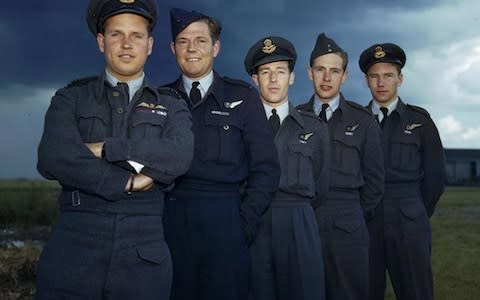
Fear and lemonade
The briefing is over, and everyone synchronises their watches to BBC time.
Barnes Wallis is worried. As a designer of weapons he is rarely this close to the men who will have to fly his creations. “I hope they all come back,” he tells Guy Gibson. “It won’t be your fault if they don’t,” Gibson says.
Now there is an hour to kill. Flight sergeant Leonard Sumpter recalls:
“You left all your kit in your bag in your locker and then you’d go back to your respective messes to have a wash and a shave, or a bath – whatever you felt like doing. No drinks, of course – just lemonade or something like that.”
The storm ahead
Squadron leader Guy Gibson is still in pain from his gout, and been up since dawn. But now he stands up for about an hour and calmly walks his men through the enemy defences.
After him the meteorologist briefs them. The sky will be clear, the moon full, and there will be very little wind.
'I know you will succeed'
Air Vice Marshal Cochrane tells the men:
“Now, you are off on a raid which will do a tremendous amount of damage. It will become historic. Everyone will want to know how you did it, and it will be very difficult not to tell them. You must not do so because we have other uses for the weapon.
“I am giving you this warning now because, having watched your training from the beginning, I know that the attack will succeed.”
The world's biggest golf ball
Barnes Wallis scribbles rapidly on a blackboard as he enthusiastically and in great detail explains the workings of his Upkeep bomb.
“It seemed incongruous,” recalls Sergeant Jim Clay, “that this kindly and quietly-spoken man should be involved with devastation.” But the more he talks the more astounded the men are.
The Upkeep works like a gigantic golf ball (though it is cylindrical, not spherical). As the bombers approach their targets a motorised belt will begin spinning it backwards at 500rpm. The backspin will make it skip across the water, clean over the torpedo nets, until it hits the dam, rolls down the wall, and explodes underwater.
In order to work properly it has to be dropped from exactly sixty feet while flying at 220mph, ideally from around 410 yards away. No pressure.

'Who's that bloody civilian?'
The briefing room is thick with smoke from pipes and cigarettes. On a raised dais, under blown-up reconnaissance photographs and a giant map of Europe, there stand some unusual figures.
Gibson is there, but so is Air Vice Marshal Cochrane, as well as an odd professor-ish gentleman with thick spectacles and a cloud of bright white hair on his head.
“Who’s the bloody civilian up there?” flight sergeant George Chalmers asks. “That’s Barnes Wallis,” his comrade replies. “Barnes Wallis?” What does he do?” says Chalmers. “You’ll find out when the briefing goes on,” comes the answer.
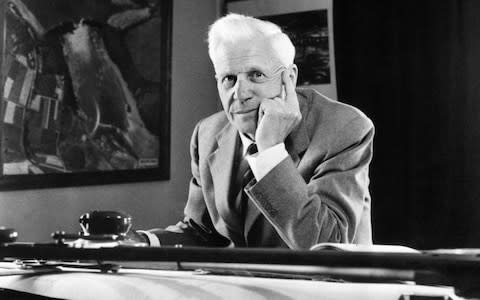
The men finally get their mission
A message goes out across the tannoy: “All crews of No 617 Squadron report ot the briefing room immediately.” It's time for the all-hands briefing.
Guy Gibson remembers:
“The boys came in hushed, having waited two and a half months to hear what it was they were going to attack. There were about 133 young men in that room, rather tousled and a little scruffy, and perhaps a little old-looking in spite of their youth. But now they were experts, beautifully trained, and each one of them knew his job as well as any man had ever known any job he was to do.”
Once everyone is inside, the doors are locked. Two military policemen stand guard outside. “It was like going into an exam room,” recalls Sergeant Fred Sutherland, a front gunner. “You could feel the tension in the air. Everybody was keyed up.”
Utmost secrecy
At the edge of the base, unnoticed to most of the crew, WAAF officer Ruth Ive is sitting in a corrugated metal hut, plugged into the airfield’s telephone exchange
Ive’s part in this operation is secret, but important. She is an expert at intercepting telephone calls. If anyone tries to phone the outside world, she is to log their identity and then cut it off.
Even she, though, does not know the actual mission.
CHASTISE gets the green light
Ralph Cochrane, the Air Vice Marshal in charge of the whole operation, gives the final authorisation for Operation CHASTISE to proceed.
Engines of war
The gigantic Upkeep bomb can only be carried by a heavy Lancaster bomber, and only after extensive modifications. Such aircraft are in short supply.
So when one of 617 Squadron’s planes is taken out of commission by mechanical difficulties, it’s worrying. Happily, there are spares, one of which is just now touching down after being flown over from Wiltshire.
But the pilot reports an engine problem. Mechanics swarm the new bird and discover a missing cable. They don’t have a spare, but they manage to fashion a replacement. The spare plane will be ready – just.

Frantic preparations
While the crew study maps and charts, squadron adjutant Harry Humphries is a whirl of activity, dashing back and forth across the base in the baking sun.
His job covers everything except the mission itself: buses to the runway, coffee rations, last suppers, bombing codes, letters for next of kin, last wills and testaments, and even making sure crewmen’s dogs are looked after. All, of course, in prohibitive secrecy.
Traditionally men who fly missions get bacon and eggs in the mess hall when they return. But the WAAF sergeant who runs the kitchens refuses to provide them for a mere “training flight”. Only when Humphries hints of the real mission does she relent.
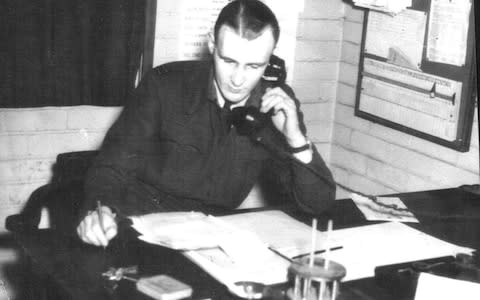
'Watch for power cables'
The bomb-aimers and gunners now join the briefing. Flying Officer Edward Johnson remembers:
“I think we were all a bit overawed at what the target was – it came straight out of the blue. Nobody had the slightest inkling before, and it took them a bit of time to digest what was going on. But it was all hubbub after the briefing was over."
Together with the pilots and navigators they begin poring over maps, discussing and marking up routes and problems with red pen and crayon. They will be flying over some of the most heavily defended countryside in Europe.
The squadron will need to fly extremely low to avoid radar – so low their training flights have knocked people off their bikes and almost capsized yachts.
Flight Lieutenant Len Sumpter makes sure to mark all the power cables that his path will cross. "They were very high, the Dutch pylons," he remembers. "They were about one hundred feet. You either had to go over or under them."
Americans notified
A signal goes out from Bomber Command in High Wycombe to Fighter Command, Coastal Command and the US 8th Air Force in Britain warning them that a “special operation” will be carried out tonight.
The target is revealed
Briefings begin at noon. At first only the pilots and navigators are allowed in. They are glad to get in out of the baking heat of the day.
Until this moment they have had no idea of their targets. So when they troop into the room they are surprised to see scale models of two hydroelectric dams: the Sorpe and the Möhne.
Gibson is there, and tells his men to study the maps and models intensely. Unfortunately there is no model of the Eder dam.
A very close call
RAF Scrampton is now a hive of activity. Officially, nobody has been told the mission is happening. Unofficially, nobody can miss it.
Instruments are checked, belts of ammunition are loaded, and the bouncing bombs – giant barrel-shaped devices weighing over 9,000 lbs, codenamed "Upkeep" – are lifted into their calipers under the heavily modified Lancaster bombers.
Without warning, one of the Upkeeps drops off the bottom of its plane and hits the ground. Everyone runs for cover, but when the Armament Officer, "Doc" Watson, approaches the bomb, he certifies it is safe.
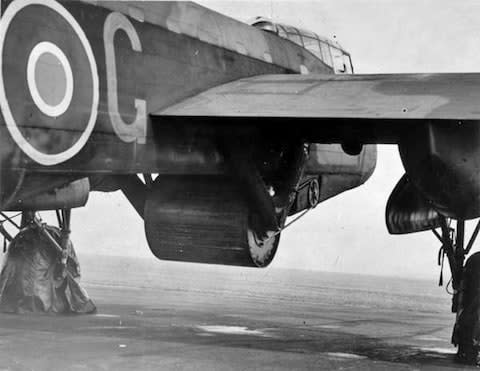
The plan is finalised
Gibson receives the final orders for the operation personally from his commander. They list routes, timings, signals, the moon and the tides. So this is really happening.
The attack will come in three waves. The first, with Gibson, will cross the coast of the Netherlands near the Belgian border and strike at the Möhne dam and then the Eder. The second wave will cross near Amsterdam and attack the Sorpe river dam. A third reserve wave will follow the first to hit any missed targets.

Preparations begin
The Met Office forecasts are good, so the mission is going ahead. But few people yet know what the actual mission is.
Gibson has told Harry Humphries, the squadron's adjutant, to prepare a night flying programme. But he is under strict instructions to pretend that it's only for training.
"We are going to war at last, but I don't want the world to know about it," Gibson has told him. "All who should know will receive their orders verbally."
Dawn
Gibsonrises at dawn, troubled by gout. Though a veteran of over 170 bombing missions, he is just 24 years old. Now he is in severe pain.
As historian Geoff Simpson tells it:
“There were various symptoms and hereditary gout was diagnosed. The medical advice that the CO should have a rest from flying was of course dismissed completely. Gibson had an objective and he was going to lead the way in meeting that objective whatever might happen.”
Gibson goes to Dr Upton, the medical officer. But given the mission he is about to fly, he is told that painkillers are out of the question. They will make him less alert. He'll have to put up with the pain.
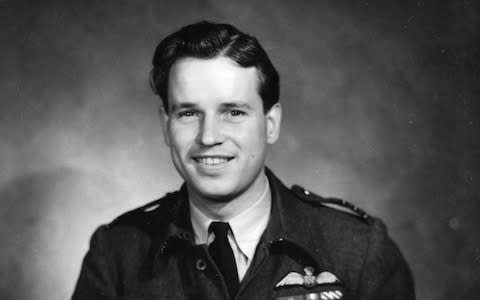
May 16, 1943
It’s the early hours of the morning and the day has not started well. Wing Commander Guy Gibson, who will be leading the squadron from RAF Scampton near Lincoln, is mourning the loss of his black Labrador.
Gibson would take his faithful hound for long walks around the airfield and he became the squadron’s unofficial mascot.
But only hours before the raid, Gibson is informed that his dog had been run over by a car outside the camp and he was killed instantaneously.
Before taking off later that day, Gibson left instructions for his faithful companion to be buried outside his office.
The name of the black labrador would later be used as a code word whenever one of the dams was breached.
